Every ten years, the National Animal Health Monitoring System (NAHMS) of the United States Department of Agriculture (USDA) conducts a thorough survey to assess the management practices of the cow-calf operation throughout the country. In May of 2020, they released the results of the survey conducted in 2017: "Beef 2017: Beef Cow-Calf Management Practices in the United States, 2017" (NAHMS Beef 2017). Those involved in the beef industry are urged to analyze this information to measure progress and detect strengths and weaknesses in the system. Furthermore, the data indicate what can be improved to ensure profitability, efficiency, and animal welfare. This series of Ask IFAS publications aims to analyze these data, select the most relevant points, and present the big picture of the US cow-calf herd practices to stakeholders (producers, Extension agents, and the public). When data from previous surveys (1997 and 2007) were available, a comparison was conducted to evaluate technologies' adoption over time. The raw data used to write this Ask IFAS series may be accessed through the USDA website. This series consists of three publications that specifically discuss the following themes: calf crop and calving distribution; breeding practices/reproductive technologies; and natural service and bull management.
Introduction
The most important outcome of a beef cow/calf enterprise is the production of a healthy weaned calf from each female (cow and heifer) each year. Without a doubt, the role of bulls is significant. It was shown in the last USDA surveys that the use of artificial insemination (AI) in the US beef industry is low, only reaching single digits. Considerations about AI were addressed extensively in a companion Ask IFAS publication (Binelli et al. 2021). Bulls have an essential role in the beef systems because of their importance in breeding cows and heifers; therefore, their welfare should be a priority for the beef cattle producer.
However, purchase and maintenance of bulls represent a high cost in the cattle operation. Therefore, special care and management of bulls are recommended before the breeding season. This article aims to present and discuss the most common management practices related to bull use that can impact cow-calf production and to share relevant statistics of bull use based on the last USDA surveys.
Bull-to-Female Ratio
This terminology refers to the number of females (cows and/or heifers) exposed and expected to be bred by a bull. Hereafter, we will use these terminologies interchangeably (bull-to-female ratio and bull-to-cow/heifer ratio). It is common to use one bull to breed many cows or heifers in cow-calf operations. However, the bull-to-female ratio varies among operations. In general, the bull-to-female ratio ranges from as low as one bull to 10 females, up to as much as one bull to 50 females. There could be several reasons for a producer to lower the bull-to-female ratio. One is the age of the bulls; fewer females are allocated to younger bulls because the bulls are considered inexperienced and still growing. A rule of thumb for the recommended maximum number of females exposed to a young bull is to use the bull’s age in months as a proxy number of females exposed to it. For example, when using a 15-month-old yearling bull, it is recommended to expose no more than 15 females to that bull in its first breeding season. Use of timed-natural breeding protocols is a reason for reducing the bull-to-cow ratio. Timed-natural breeding uses a round of estrus synchronization followed by natural breeding without AI. Many females will go into heat in a concentrated and short period in response to synchronization protocols. Therefore, there is a need for extra bull power to ensure a good pregnancy outcome.
In other situations, producers may use a high bull-to-female ratio, resulting in more cows and/or heifers exposed to each bull. One scenario exemplifies the low bull-to-cow ratio when mature and high-performance bulls are used. This is possible for fully grown bulls, who performed well on the breeding soundness evaluation and showed outstanding results in the previous breeding season. Another scenario using a high bull-to-female ratio is when clean-up bulls are used after AI. In that situation, because a high proportion of females could be pregnant from the AI, the number of bulls is reduced.
In 2017, producers were asked how many females they placed per bull during the breeding season, according to bull category (yearling or mature). On average, yearling bulls were exposed to 15.2 females, while mature bulls were exposed to 22.3 females. Interestingly, a direct increase in the number of females exposed per bull was reported as herd size increased (Figure 1). When comparing the results of the 2017 survey with the previous years (1997 and 2007), the bull-to-female ratio was steady in the last two decades but decreased slightly, as shown in the 2017 report (Figure 1). In 1997, a yearling bull was exposed to 17.5 females, while a mature bull was exposed to 25.3 females, on average. The ratios were similar from 1997 and 2007; however, there was a 15% drop in the number of females exposed to yearling bulls and a 10% drop for mature bulls in the 2017 survey. The recent trend of exposing fewer females per bull suggests that ranchers may want to ensure the breeding season's success by having enough bull power to serve their females, or that there is a perception that the bull’s capacity is underestimated. Additional information on the reproductive soundness and performance of bulls could lend context to this change.
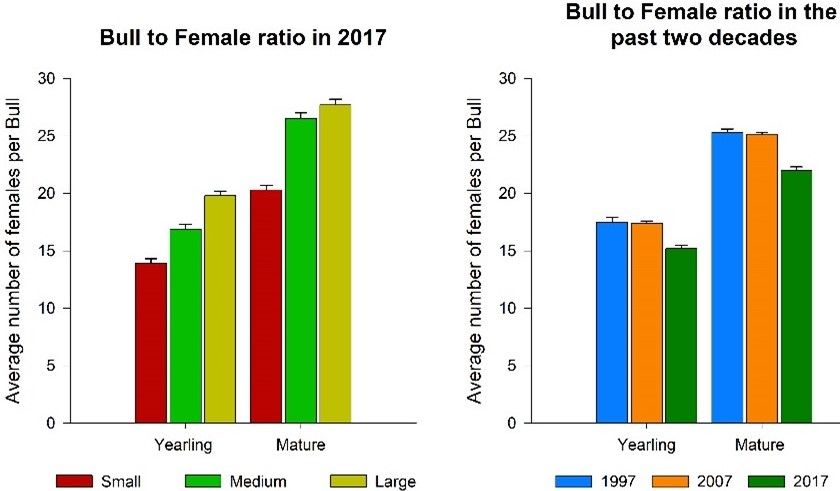
Credit: NAHMS Beef (2017)
Type of Bulls Used and Introduction of Bulls to the Herd
Bulls are expected to serve the herd for several years to maximize the return on the investment. It is common to purchase and introduce young and virgin bulls (yearlings) to the herd. Reducing the breeding pressure by lowering the bull-to-female ratio is recommended when a new yearling bull is introduced into the herd. As yearling bulls mature and become fit for breeding more cows, ranchers can increase the bull-to-female ratio and expose mature cows to these mature bulls without the risk of compromising the calf crop. Considerations and reasons for adding new bulls to the herd include reducing inbreeding, improving genetics, and replacing culled bulls (e.g., due to age, injury, sale, poor reproductive performance, failing the bull breeding soundness exam).
In the 2017 survey, 28.5% of beef cattle operations introduced new bulls into their herds to be used during the last breeding season (either purchased, leased, or borrowed). There was a direct association between herd size and the percentage of bulls introduced to the herd. Specifically, fewer small operations introduced new bulls compared to medium and large operations (23.1%, 39.4%, and 61.3%, respectively; Figure 2). When evaluating the type of bulls introduced by herd size, small operations introduced older bulls (18 months or older, not considered virgins) in a higher proportion than medium and large operations (64.2% 42.8%, and 40.3%, respectively; Figure 2).
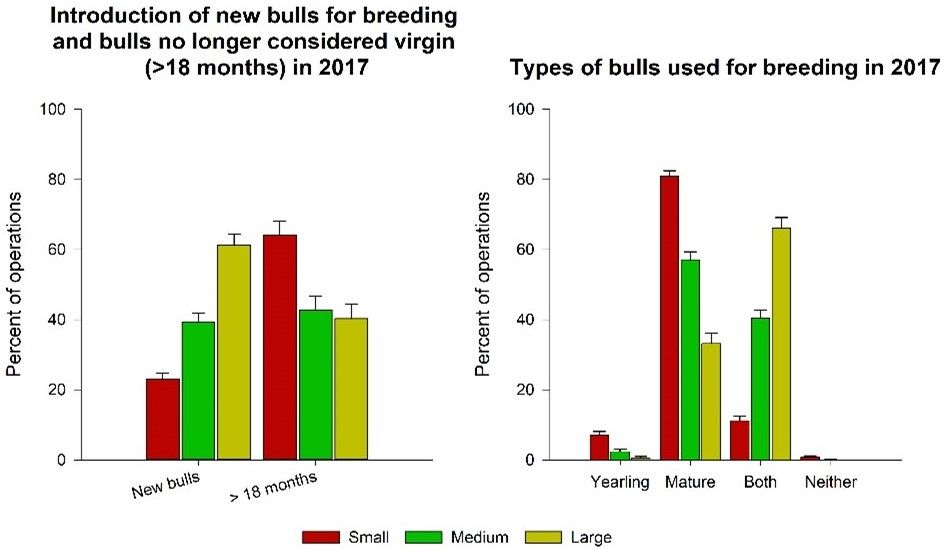
Credit: NAHMS Beef (2017)
Small operations keep bulls in the herd longer and rely more upon mature bulls for breeding compared to large operations. Small operations that introduce new bulls to the herd do so by bringing mature and non-virgin bulls at a greater proportion than larger operations. Pay attention to the soundness of mature bulls throughout their productive life and the level of inbreeding possibly occurring in the herd. Be aware of the increased risks of introducing venereal diseases when bringing older bulls into a herd.
Bull Breeding Soundness Exam (BSE)
The bull BSE brings information that helps the ranchers make sound decisions to maximize a bull’s influence on pregnancy rates. The BSE should be performed by trained veterinarians, following a thorough evaluation of the bull (Koziol and Armstrong 2018). Specifically, the exam will consist of the evaluation of the bull's physical condition (eyes, mouth, nose, skin, feet and legs, overall body structure, and conformation in general) and reproductive components (testis, epididymis, scrotum, accessory sex glands, prostate, prepuce, sheath, and penis), and lastly, the collection of a sample of semen to be analyzed for motility and morphology. Spermatozoids need to swim all the way from the vagina, passing the cervix to the end of the uterine horns, to reach the oviduct, where fertilization will take place. Therefore, evaluation of motility is necessary to assure the presence of a minimum number of spermatozoids that can swim forward and reach the female egg. A more detailed and essential part of the semen evaluation is morphological analysis. The veterinarian will prepare a slide smear and stain the spermatozoids. Under the microscope, spermatozoa will be classified as normal (Figure 3, left panel) or abnormal (Figure 3, central and right panels). Even though this procedure takes a little extra time, it brings important information to the BSE and contributes to the final classification of the bulls as satisfactory or not satisfactory for breeding.
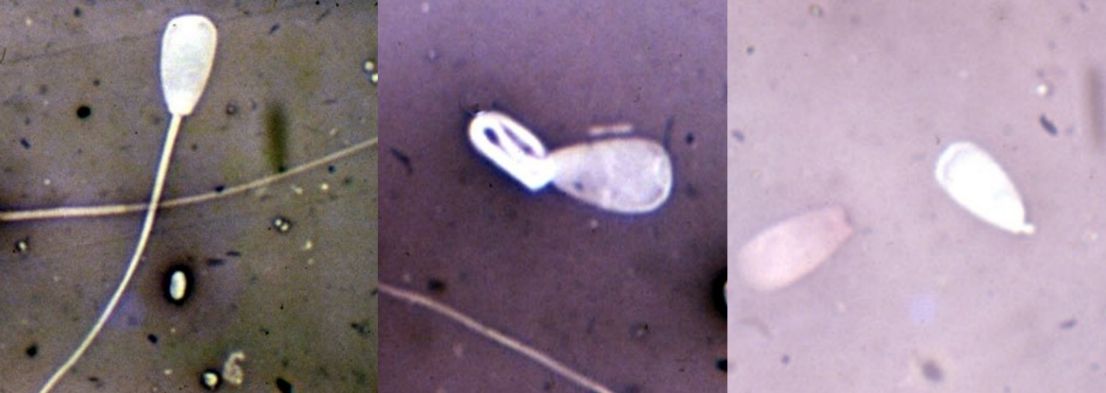
Credit: Larsen, R. E. 2001. “Visual Guides of Animal Reproduction (VisGAR).” University of Florida College of Veterinary Medicine. https://visgar.vetmed.ufl.edu/
Libido or service capacity is not typically evaluated during the BSE. Nevertheless, this should not be used as an excuse for not evaluating the bulls' soundness before exposing them to the cows and/or heifers.
Ideally, the BSE should be performed at least 60 days before turning the bulls with cows or heifers. This interval is recommended to allow enough time to reevaluate bulls classified as deferred in the BSE. A significant percentage of yearlings are expected to be classified as deferred in the BSE. More time is needed for them to reach sexual maturity, and a second BSE will verify that.
Conditions in which bulls are kept and managed may have negative impacts on bull performance. Such conditions include but are not limited to rough and large pasture areas, climate, environmental challenges, ectoparasites, competition with multiple bulls serving the same group of cows, and introduction to new bulls. These conditions are common in the southeastern United States, especially in Florida; therefore, bulls may experience a relatively greater risk of becoming sick or injured, which is expected to impact their libido and performance. Thus, it is highly recommended that ranchers test their bulls at least once a year before the beginning of the breeding season. The annual bull BSE should not be considered a cost but an investment to secure the success of the upcoming breeding season, at least from the bull’s side.
Producers were asked if the new bulls entering the operation were submitted to reproductive examination. For the 28.5% of operations that introduced bulls for the previous year's breeding season, on average, 66.8% of the bulls were semen-checked. However, checking varied considerably according to herd size. Semen testing in new bulls introduced to the herd was conducted in 51.6%, 87.2%, and 96.4% of the small, medium, and large operations, respectively (Figure 4).
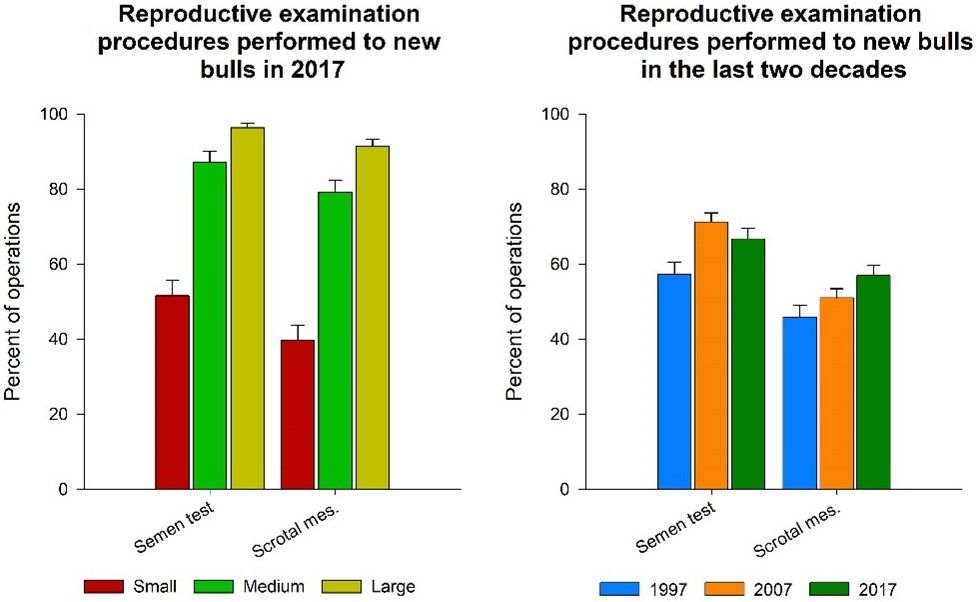
Credit: NAHMS Beef (2017)
Similar results were observed when producers were asked about scrotal circumference measurement in new bulls introduced to the herd (Figure 4). Only 38.7% of the small producers measured scrotal circumference, compared to 79.3% and 91.4% of medium and large operations, respectively. When previous reports were compared, 57.3% and 71.3% of the operations performed semen checks to new bulls introduced to the herd in the 1997 and 2007 surveys, respectively.
Next, producers were asked about the reproductive examinations conducted on old bulls. Old bulls were already on the ranch and considered experienced. In the 2017 survey, only 31.4% and 22.1% of the producers semen-tested and measured the scrotal circumference of old bulls, respectively. Fewer small operations used those techniques in old bulls compared to medium and large operations (semen test: 24.2%, 48.1%, and 67.2%, respectively; Figure 5). The use of reproductive examination in old bulls from the 2017 survey was higher compared to the previous years' surveys. In 1997, only 17.3% and 9.8% of the old bulls were submitted to semen check and scrotal measurement, respectively. In 2007, these percentages were 26.8% and 15.6%, respectively (Figure 5).
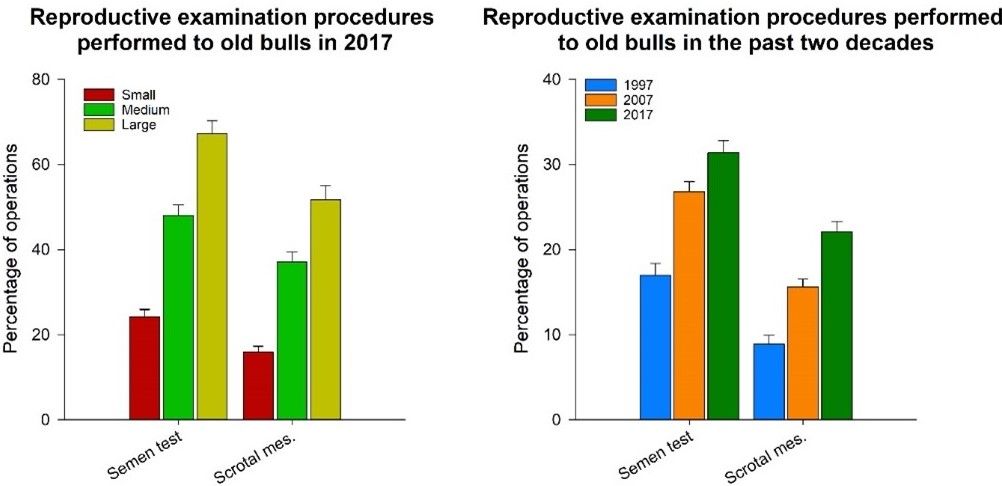
Credit: NAHMS Beef (2017)
There was a direct association of herd size and the use of reproductive examination and an increased adoption rate of these evaluations since 1997. The use of scrotal circumference measurement was lower than the use of semen testing reported in all surveys, even though both practices are part of a thorough bull BSE.
Tritrichomonas foetus Test
The risk of beef cattle contracting venereal diseases in Florida is relatively high. Tritrichomonas foetus (also called "Trich") is one of the most important pathogens affecting bulls and inducing reproductive losses in beef cattle herds. Testing for this common venereal disease is highly recommended. Since bulls will be restrained for the BSE, ranchers should collect samples to test for common venereal diseases. In conjunction with the bull BSE, the sampling and testing for venereal diseases should be prioritized as a routine chore before the breeding season starts.
In 2017, producers were asked about testing their new bulls for Trich. Only about half of the producers tested (53.6%), and there was only a small variation according to the operation’s size (46.9%, 62.2%, and 67.3% for small, medium, and large herd size, respectively; Figure 6). However, there was a significant discrepancy in Trich testing for old bulls. Only 20.8% of the producers tested old bulls for Trich, with a considerable difference among small (17.6%), medium (26.6%), and large (43.3%) operations (Figure 6). A similar question was asked in the 1997 and 2007 surveys (Figure 6). In the 1997 report, less than 5% of the operations tested old bulls already present in the farm for Trich. This proportion doubled (9.8%) for the 2007 report.
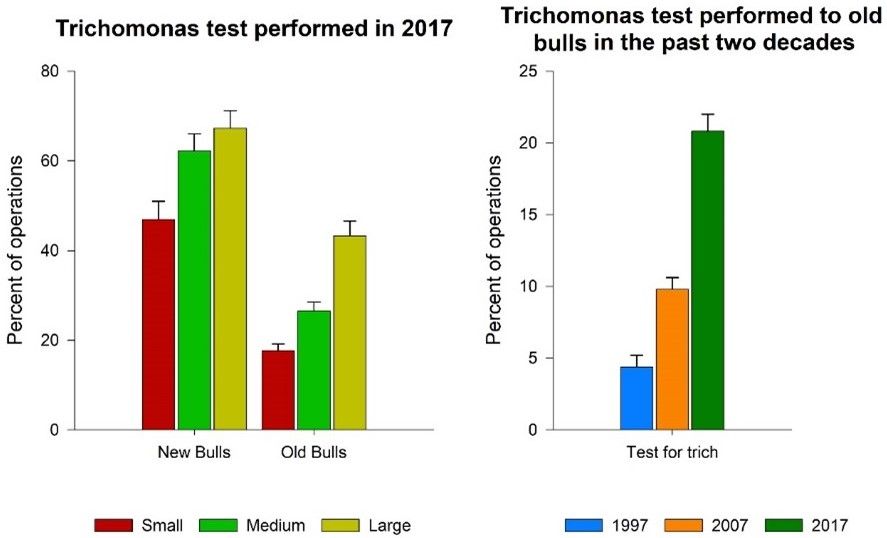
Credit: NAHMS Beef (2017)
Sire Identification DNA Testing
It is common to have a group of females exposed to multiple bulls for breeding purposes. This situation is commonly observed in medium and large operations, in which a group of bulls is needed to match the required bull-to-cow ratio. Such a management practice creates the challenge of evaluating an individual bull's breeding performance—specifically, how many and which females were bred by which bull. Modern DNA testing technologies are now commercially available to provide calf crop paternity information. Only data collected in the 2017 USDA survey are available. Overall, there was a low use rate of this technology; only 3.6% of the operations DNA-tested cattle for sire identification. Small operations used DNA testing in a lower proportion (2.6%) than medium and large operations (5.6% and 10.6%, respectively; Figure 7). When asked if they used only one bull in the herd, 20.8% of the small operations responded that they used only one bull, compared to 8.8% and 1.4% for medium and large operations, respectively (Figure 7). However, 76.6%, 85.6%, and 88% of small, medium, and large operations, respectively, had more than one bull serving the herd and did not use DNA testing for sire identification in the 2017 survey.

Credit: NAHMS Beef (2017)
After the analysis of the three NAHMS Beef Cattle reports, the most relevant information on bull type used and bull management from the reports can be summarized as follows:
- The bull-to-female ratio decreased slightly over the previous two decades, regardless of the bull type used (i.e., yearling or mature).
- There is a clear difference in how small operations manage bulls and which type of bulls they introduce to their operations compared to medium and large operations. Small operations tend to use a single bull and keep bulls longer for breeding compared to medium and large herds.
- The reproductive examination (semen test, scrotal measurements) and Trich test were performed more frequently in new bulls introduced to the herd than in bulls already present in the herd. Additionally, there was an increase in the proportion of ranches performing reproduction evaluations (semen test and scrotal measurements) in old bulls since the last two reports, but it is still low.
- Testing for the venereal parasite Tritrichomonas foetus was reported mostly for new bulls introduced in the herd, especially in the large operations. The Trich testing rate has increased since 1997; however, it is still low, especially for bulls already present in the operations.
- Commercial DNA testing for sire identification recently became available to beef cattle producers. The percentage of operations utilizing this technology is still low.
In conclusion, these surveys showed that there is room for improvement regarding the use of important reproductive and health evaluations for bulls. Considering most of the breeding in the beef cattle industry is done by natural service, the bulls are critical components of the herd's reproductive success.
References
Koziol, J. H., and C. L. Armstrong. 2018. Society for Theriogenology Manual for Breeding Soundness Examination of Bulls. Second Edition.
Larsen, R. E. 2001. “Visual Guides of Animal Reproduction (VisGAR).” University of Florida College of Veterinary Medicine. https://visgar.vetmed.ufl.edu/
Nichols, M., and J. Thompson. 1987. "Field Application of a Bull Breeding Soundness Examination." Iowa State University. Veterinarian 49(1): Article 10.
United States Department of Agriculture (USDA): APHIS: VS. 1998. “Part IV: Changes in the U.S. Beef Cow-Calf Industry, 1993–1997.” Centers for Epidemiology and Animal Health. Fort Collins, CO. #N238.398. https://www.aphis.usda.gov/animal_health/nahms/beefcowcalf/downloads/beef97/Beef97_dr_PartIV.pdf
United States Department of Agriculture (USDA). 2008. “Beef 2007–08, Part III: Changes in the U.S. Beef Cow-Calf Industry, 1993–2008.” USDA: APHIS: VS, CEAH. Fort Collins, CO. #N518.0509. https://www.aphis.usda.gov/animal_health/nahms/beefcowcalf/downloads/beef0708/Beef0708_dr_PartIII_1.pdf
United States Department of Agriculture (USDA). 2020. “Beef 2017: Beef Cow-Calf Management Practices in the United States, 2017, Report 1.” USDA–APHIS–VS–CEAH–NAHMS. Fort Collins, CO. #782.0420. https://www.aphis.usda.gov/animal_health/nahms/beefcowcalf/downloads/beef2017/Beef2017_dr_PartI.pdf